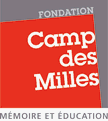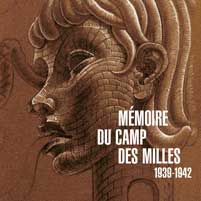
History, memory, museography
Olivier Lalieu Historian
In the first place, the exhibitions were to aim at recounting the history of the Camp des Milles and its annexes in Provence as faithfully as possible, making the distinction very clear between the three periods they cover. The Camp des Milles was opened in September 1939 under the Third Republic for the internment of those coming from “enemy powers” in the Marseille area, then under the Vichy government, it became an internment camp for “undesirables” and a transit camp for those likely to emigrate abroad. A third period opened in August and September 1942, when the site became the rallying point for more than 2,000 targeted Jewish men, women and children rounded up and interned with a view to their deportation by the Nazis to Auschwitz-Birkenau extermination camp, via the Camp de Drancy, with close help from the French State. Before the German occupation of the site in the winter of 1942-1943, the French authorities were the only ones in charge of the camp, with the period marked by the visit of the Kundt Commission in August 1940 and the Dannecker one in July 1942. Otherwise, the only Germans present would have been internees. So this is not a linear story; it was subject to two different political regimes and depended on two entirely different ways of thinking. Depriving a person of his or her liberty can never be a neutral act, and by late summer of 1942, the results were disastrous for all deported Jews.
The visit has therefore been conceived around the chronological sequence of these three phases, continuities and ruptures included. Thus, Jewish internees made up the largest group between 1939 and 1942, even though the reason behind their detention varied according to the period. Nevertheless, the museum visit traces the fate of all categories of internees very clearly, without dissimulation or amalgamation.
We wanted also to confront some of the most emblematic individual life stories with the historical account of each period, so as to bring History alive in concrete terms. Amongst the mass of internees or actors from the charity associations that came to their aid, some twenty stories were finally selected, some tracing the life path of famous personalities such as Lion Feuchtwanger and Varian Fry, others that of unknown people.
The exhibition contents had to be comprehensible to a wide public, French or foreign, through the adoption of different levels of understanding, including one specially for children. The suggested starting point here was the career and work of Franz Meyer, the German draughtsman and militant antifascist interned in Les Milles before his emigration to the USA in 1942.
Read an excerpt from the text by Robert Mencherini.
Read an excerpt from the text by Angelika Gausmann.
Read an excerpt from the text by Atelier Novembre.
See a preview of the book. (Flash sequence)
Memory of the Camp des Milles 1939-1942
Photographs
Yves Jeanmougin
Texts
Robert Mencherini
Angelika Gausmann
Olivier Lalieu
Atelier Novembre
Preface by Alain Chouraqui
Photos published in this book were taken between 2008 and 2012.
Hardcover book / 27 x 27 cm in size / 240 pages /
360 illustrations in both b & w and colour
Métamorphoses / Le Bec en l’air (2013)
ISBN 978-2-916073-97-2
29 €
Also available in French:
Mémoire du camp des Milles 1939-1942
Edition produced in partnership with:

and with the help of:

This book is available at the Camp des Milles Memorial Site,
in bookshops or directly from:
Métamorphoses
Friche la Belle de Mai 41 rue Jobin 13003 Marseille / France

Download the order form
meta@metamorphoses-arts.com
Olivier Lalieu Historian, Olivier Lalieu is in charge of the rehabilitation, development and external projects of the Shoah Memorial. He is also a member of the Scientific Council of the Camp des Milles Foundation – Memory and Education, and curator of the historical and memory exhibitions on the Camp des Milles Memorial Site. His most notable publication is La Zone grise ? La Résistance française à Buchenwald, Tallandier, 2005 (new edition Texto, 2012).

